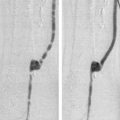Sedation is used to relax patients during procedures but does not relieve or prevent pain. Hence, sedation is often used in combination with analgesia. Sedation is useful in patients undergoing prolonged interventional procedures and can also be valuable in anxious or hypertensive patients.
Remember that sedation may result in respiratory depression and aspiration of gastric contents; in addition, there is a small but significant mortality. Children are at particular risk.
This chapter defines ‘conscious sedation’ and outlines patient selection and management within the radiology department. If you have any doubts about your ability to manage a particular patient, seek advice from an anaesthetist.
Conscious sedation
This refers to a controlled state of reduced consciousness throughout in which the patient retains the ability to make purposeful, verbal responses. Protective reflexes are preserved and the airway is maintained. Drugs used in conscious sedation should have a sufficient margin of safety to make unintended loss of consciousness unlikely.
If verbal responsiveness is lost, the patient requires a level of care identical to that needed for general anaesthesia and mandates anaesthetic assistance.
Deep sedation and anaesthesia
These involve a further reduction in conscious level from which the patient is not readily roused and during which protective reflexes and the ability to maintain the airway may be lost, along with the ability to respond to physical and verbal stimulation. In terms of patient management, deep sedation should be regarded as a form of general anaesthesia.
Close clinical observation and monitoring are vital during conscious sedation; machines do not detect responsiveness. Someone must maintain verbal and tactile contact with the patient and assess the patient’s mental state and alertness.
To sedate or not to sedate, that is the question
Practices differ widely between countries and cultures. Patient tolerance varies enormously; it is unnecessary to use sedation routinely. Try to establish whether sedation is likely to be required before starting the procedure. In this way, the patient can be properly assessed and risk minimized.
Take time to talk to the patient before, during and after the procedure and you will find that the majority of patients are not distressed if they are actively reassured and not in pain. Remind them that if they become anxious or distressed, sedation can be administered during the procedure. Consider sedation in the following circumstances:
- •
Prolonged procedures where the patient is likely to become uncomfortable
- •
Patients who remain very anxious despite explanation and reassurance
- •
Painful procedures. It is important not to equate sedation with analgesia, and if performing a painful procedure, give adequate analgesia. Remember that sedation and strong analgesia are synergistic, and take care
- •
Patients who are unlikely to cooperate, e.g. children. Now you have considered it, dismiss the idea – agitated or confused patients often become unmanageable following even light sedation. In these circumstances, you need anaesthetic support and general anaesthesia may be the safest option.
Stay updated, free articles. Join our Telegram channel

Full access? Get Clinical Tree



